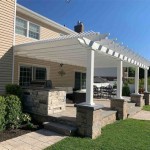How To Build A Freestanding Covered Patio
A freestanding covered patio represents a significant enhancement to outdoor living spaces. It provides shelter from the elements, creating a comfortable area for relaxation, entertainment, and dining. Unlike attached patios, a freestanding structure offers flexibility in placement and design, allowing homeowners to customize their outdoor environment according to specific needs and aesthetic preferences. Building a freestanding covered patio is a complex project requiring careful planning, adherence to building codes, and proficient construction skills. This article outlines the fundamental steps involved in constructing such a patio, providing a comprehensive guide for those undertaking this ambitious endeavor.
Planning and Preparation
The initial stage involves meticulous planning and preparation. This phase is critical for ensuring the structural integrity, functionality, and aesthetic appeal of the final product. Neglecting this stage can lead to costly errors and delays later in the construction process.
First, determine the desired size and location of the patio. Consider factors such as the intended use of the space, the orientation to the sun, prevailing winds, and proximity to existing structures. Larger patios will require more materials and labor, while the location will influence the level of sun exposure and wind protection. It's also important to consider the existing landscape and how the patio will integrate with the surrounding environment.
Next, obtain necessary permits and approvals. Building codes vary by jurisdiction, and it's essential to comply with all regulations to avoid fines or legal issues. Contact the local building department to inquire about permit requirements, setback regulations, and other relevant codes. This may involve submitting detailed plans and drawings of the proposed structure.
Develop a detailed design and blueprint. This should include the dimensions of the patio, the type of roofing material, the support structure (posts, beams, and rafters), and any additional features such as lighting or electrical outlets. The blueprint should also specify the materials to be used, including the type of wood, fasteners, and roofing materials. Consider using structural engineering software or consulting with a structural engineer to ensure the design is structurally sound and complies with building codes.
Gather the necessary tools and materials. This includes lumber, roofing materials, concrete mix, posts, beams, rafters, fasteners (nails, screws, bolts), measuring tape, level, square, saw, drill, post hole digger, concrete mixer (optional), and safety equipment (gloves, eye protection, and hearing protection). Purchasing high-quality materials will ensure the longevity and durability of the patio.
Prepare the site. This involves clearing the area of vegetation, debris, and any obstructions. Level the ground and ensure proper drainage to prevent water from pooling under the patio. Consider adding a layer of gravel or crushed stone to improve drainage and stability. If the patio will be built on uneven ground, additional excavation and grading may be required.
Constructing the Foundation and Support Structure
The foundation is the backbone of the patio, providing stability and support for the entire structure. A well-constructed foundation is essential for preventing settling, shifting, and other structural problems.
First, mark the location of the posts. Use the blueprint to determine the precise location of each post and mark it with stakes or paint. Ensure the posts are evenly spaced and aligned to provide adequate support for the roof.
Dig post holes. The depth of the post holes should be determined by the frost line in the area, typically ranging from 24 to 48 inches. The diameter of the holes should be wide enough to accommodate the posts and a layer of concrete. Use a post hole digger or an auger to create the holes.
Set the posts in concrete. Place the posts in the holes and ensure they are plumb and level. Use temporary braces to hold the posts in place while the concrete sets. Mix the concrete according to the manufacturer's instructions and pour it into the holes around the posts. Use a level to ensure the posts remain plumb during the concrete pouring process. Allow the concrete to cure for several days before proceeding with the next step.
Install the beams. Beams are horizontal structural members that support the rafters and distribute the load evenly across the posts. Attach the beams to the posts using appropriate fasteners, such as bolts or lag screws. Ensure the beams are level and securely fastened to the posts.
Construct the frame. The frame provides a solid base for the roofing materials. This involves attaching additional lumber to the beams to create a rectangular or square frame. The frame should be level and securely fastened to the beams. Consider adding diagonal bracing to the frame to improve stability and prevent racking.
Installing the Roof
The roof provides shelter from the elements and defines the aesthetic character of the patio. Choosing the right roofing materials and installing them correctly is crucial for ensuring the patio is weather-resistant and visually appealing.
Install the rafters. Rafters are sloping structural members that support the roofing material. They are typically spaced 16 to 24 inches apart, depending on the type of roofing material and the snow load in the area. Attach the rafters to the frame using appropriate fasteners. Ensure the rafters are evenly spaced and aligned.
Sheathe the roof. Sheathing provides a solid surface for the roofing material. This typically involves attaching plywood or oriented strand board (OSB) sheets to the rafters. Ensure the sheathing is securely fastened to the rafters and that there are no gaps or overlaps.
Install the roofing material. There are various roofing materials to choose from, including asphalt shingles, metal roofing, wood shakes, and polycarbonate panels. The choice of roofing material will depend on factors such as cost, durability, aesthetic preferences, and local building codes. Install the roofing material according to the manufacturer's instructions. Ensure the roofing material is properly sealed to prevent leaks.
Add flashing. Flashing is a thin, impervious material installed to prevent water from entering the structure at vulnerable points, such as where the roof meets the posts or walls. Install flashing around the posts, along the edges of the roof, and in any areas where water is likely to accumulate.
Consider adding gutters and downspouts. Gutters and downspouts help to channel rainwater away from the patio, preventing water damage and erosion. Install gutters along the edges of the roof and connect them to downspouts that direct the water away from the patio foundation.
Additional Considerations
Beyond the basic structural elements, several additional considerations can enhance the functionality and aesthetic appeal of a freestanding covered patio.
Lighting and Electrical Outlets: Integrate lighting into the design to extend the usability of the patio into the evening. Options include string lights, recessed lighting, or wall-mounted fixtures. If electrical outlets are desired, plan for wiring during the construction phase and ensure compliance with electrical codes. Consider hiring a qualified electrician to handle the electrical work.
Flooring Options: While the ground beneath the patio can be left as natural ground, consider adding a patio surface for added comfort and aesthetics. Options include poured concrete, pavers, decking (wood or composite), or gravel. Each option presents different benefits in terms of cost, maintenance, and appearance.
Privacy Screens and Windbreaks: To enhance privacy and protection from the elements, consider adding privacy screens or windbreaks around the perimeter of the patio. These can be constructed from wood, metal, fabric, or plants. The design should integrate seamlessly with the overall aesthetic of the patio.
Landscaping: Surrounding the patio with landscaping can create a more inviting and natural environment. Consider adding plants, shrubs, trees, and flowers that complement the design of the patio. Proper landscaping can also help to improve drainage and prevent erosion.
Furniture and Decor: Select furniture and decor that are appropriate for outdoor use and that complement the style of the patio. Consider adding comfortable seating, a dining table, a grill, and other accessories that will enhance the enjoyment of the space.
Regular Maintenance: Regular maintenance is essential for preserving the longevity and appearance of the patio. This includes cleaning the roof and gutters, inspecting the structure for signs of damage, and applying sealant or stain as needed. Addressing minor issues promptly will prevent them from escalating into more significant problems.

Building A Patio Cover Plans For An Almost Free Standing Roof

Building A Patio Cover Plans For An Almost Free Standing Roof

Diy Freestanding Patio Cover The Duvall Homestead

How To Build A Freestanding Patio Cover With Best 10 Samples Ideas

Building A Patio Cover Plans For An Almost Free Standing Roof

How To Build A Diy Covered Patio

Building A Covered Patio With 30ft Span The Awesome Orange

Diy Freestanding Patio Cover The Duvall Homestead

Patio Roof Gazebo Construction Hometips

How To Build A Freestanding Patio Cover With Best 10 Samples Ideas








